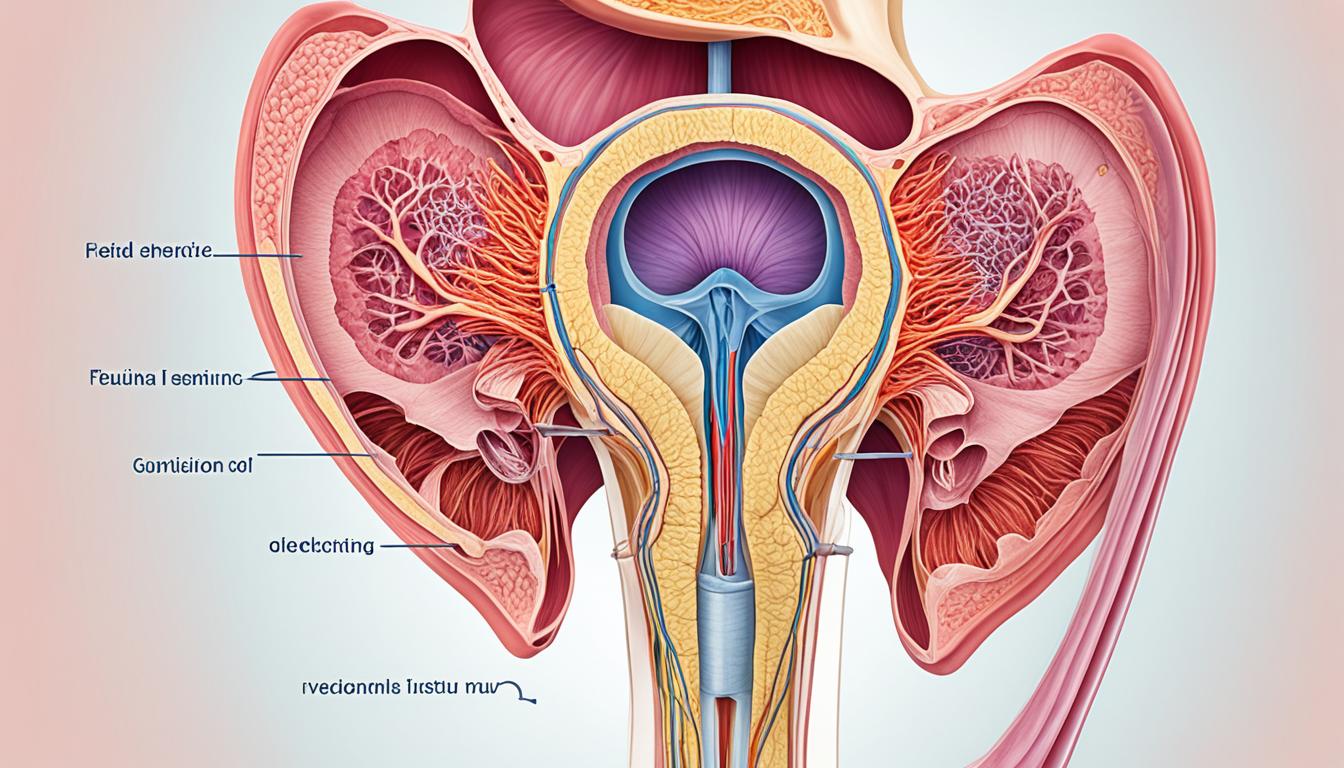A vaginal fistula creates an odd opening between the vagina and another part. This could be the bladder, colon, or rectum. Many things can cause this, such as giving birth, getting hurt, or having surgery. Infections or radiation treatment can also lead to it. There are many kinds, like bladder, ureterovaginal, rectovaginal, and colovaginal.
Having urine or stool come out when you don’t want them to is a common sign. So are repeated infections in your vagina and a bad smell or bloody urine. Sex might hurt, and your perineal area could be swollen or irritated. If you see any of these signs, see a doctor right away.
Key Takeaways:
- A vaginal fistula is an abnormal opening between the vagina and another organ.
- Causes of vaginal fistulas include childbirth, injury, surgery, infection, and radiation treatment.
- Common symptoms of vaginal fistulas include urine or stool leakage, frequent urinary tract infections, abnormal discharge, pain during sex, and swelling in the perineal area.
- Seek medical attention if you experience these symptoms for proper diagnosis and treatment.
- Stem cell therapy is a potential treatment option for vaginal fistulas, but further research is needed to determine its effectiveness.
Causes of Vaginal Fistula
Vaginal fistulas can be caused by multiple factors. These include:
- Childbirth injuries: Tearing or infection during delivery can cause a fistula.
- Surgical complications: Some surgeries might lead to fistula formation. This can be due to injuries or post-surgery infections.
- Crohn’s disease: This illness, affecting the digestive tract, can result in a fistula.
- Cancer: Certain cancers, like anal or cervical cancer, can raise the risk of a fistula.
- Radiation therapy: Treatment for pelvic cancer, like radiation, might lead to fistula formation.
Knowing the causes is vital for preventing and treating vaginal fistula. Healthcare workers can use this info to lower the chances of getting a fistula in those at risk.
Frequency of Vaginal Fistula Formation
The frequency of fistula formation changes. It depends on the cause and the person’s health. Childbirth injuries are a major cause, especially in places with poor medical care or risky cultural practices.
Surgery, Crohn’s disease, or cancer are less common reasons. But, they still impact many people. They need quick diagnosis and treatment.
Symptoms and Diagnosis of Vaginal Fistula
Recognizing and diagnosing vaginal fistulas early is key to successful treatment. Common signs of a vaginal fistula include:
- Urine or stool leaking through the vagina, which can be embarrassing
- Recurrent urinary tract infections, causing discomfort and health issues
- Strange vaginal discharge in smell or look
- Pain during sex, affecting intimacy
- Perineal pain located between vaginal and rectal openings
- Recurrent vaginal infections from poor vaginal hygiene and function
Symptoms can change based on the fistula’s position and seriousness. If you notice any of these, it’s crucial to see a doctor for a full check-up and a defined diagnosis.
A medical check will likely be done. It includes a deep look at the vaginal and rectal areas to spot any fistulas. This step helps doctors know the size and place of the problem, guiding how to treat it.
An accurate diagnosis is the start of the right treatment for vaginal fistulas. Treating it early can help a lot, improving life quality for those impacted.
| Signs and Symptoms | Potential Causes |
|---|---|
| Urine or stool leakage through the vagina | Damage during childbirth |
| Recurrent urinary tract infections | Surgical complications |
| Abnormal vaginal discharge | Crohn’s disease |
| Pain during sexual intercourse | Cancer (vaginal, rectal, anal, cervical) |
| Perineal pain | Radiation therapy |
| Recurring vaginal infections |
If you think you might have a vaginal fistula, see a doctor for a correct diagnosis. Getting treated quickly and correctly is essential for dealing with vaginal fistulas.
Stem Cell Therapy for Vaginal Fistula
Stem cell therapy, using allogeneic adipose-derived stem cells, shows hope in treating vaginal fistulas. These cells come from healthy donors. They possess properties that help reduce inflammation and regulate the immune system, assisting in tissue healing.
Early studies suggest this therapy is safe and doable, but its success might be limited. More controlled studies are necessary. These studies aim to confirm the therapy’s usefulness for vaginal fistulas and to make stronger claims.
This therapy presents a new possibility for treating vaginal fistulas. It hopes to enhance patient outcomes and their quality of life. Nonetheless, detailed research remains essential to completely grasp the treatment’s success and safety with these specific stem cells.
Thanks to ongoing scientific progress, more studies will push towards better and personalized treatment strategies for vaginal fistulas. This will hopefully result in more successful patient outcomes.

